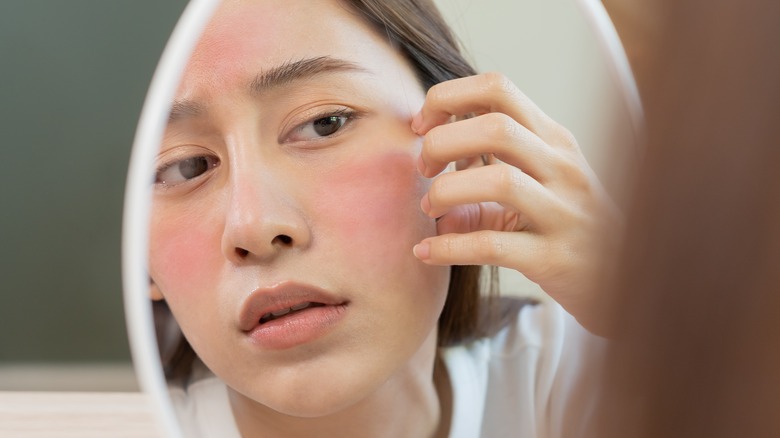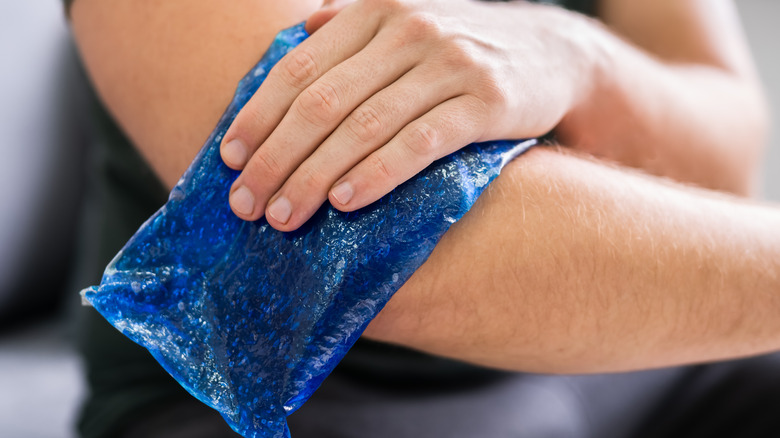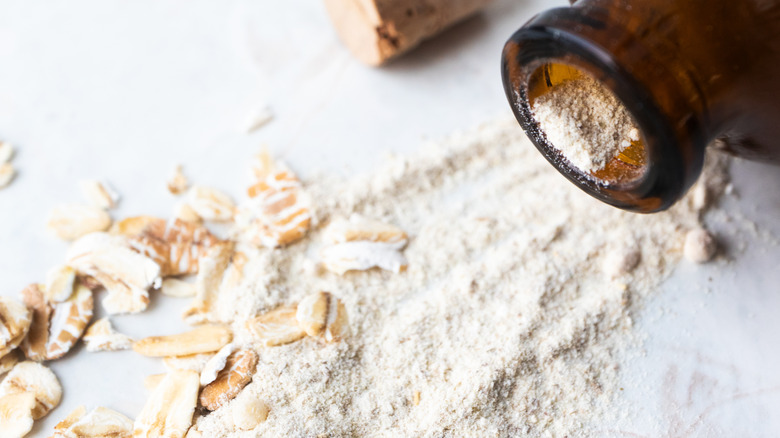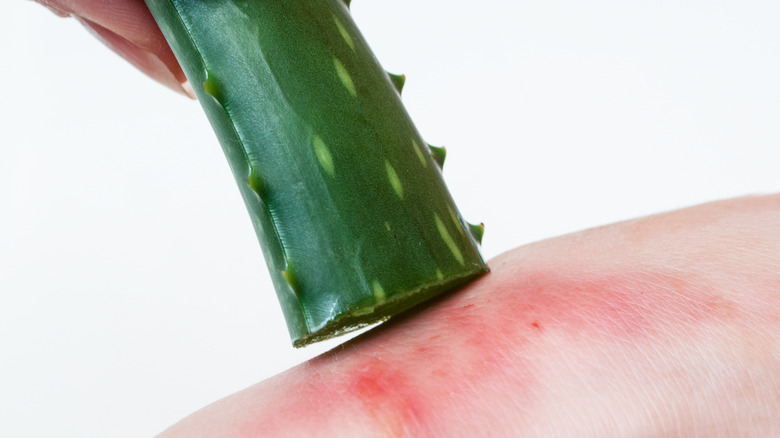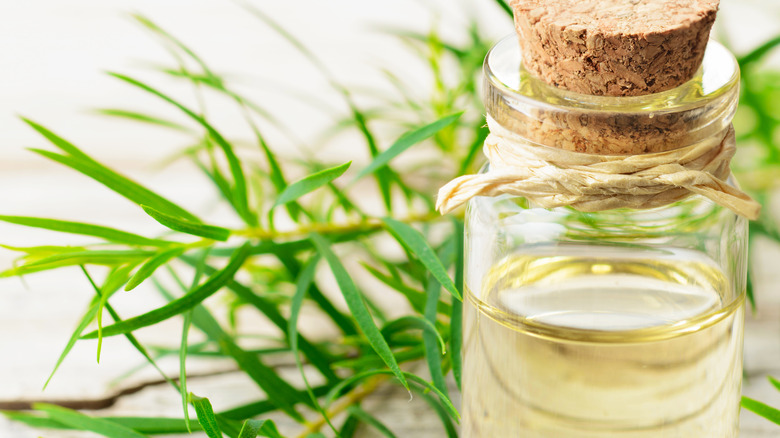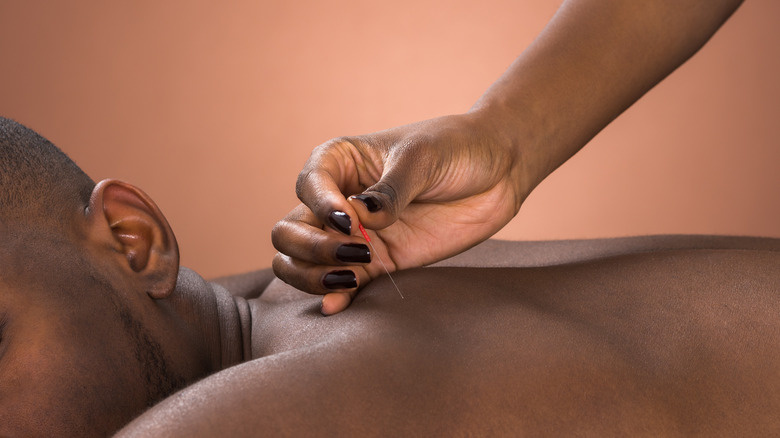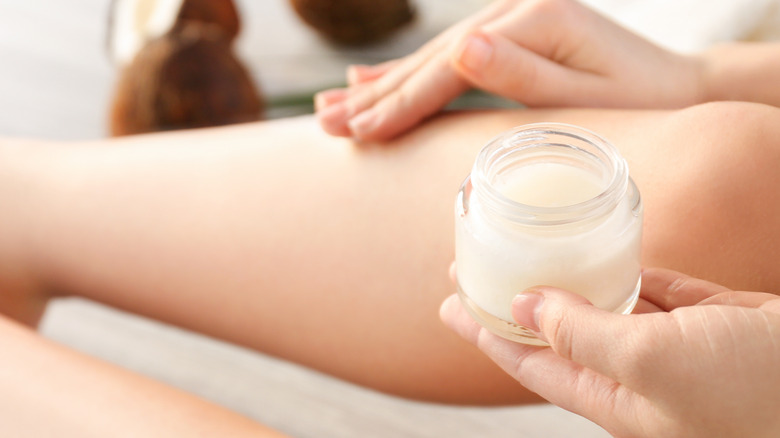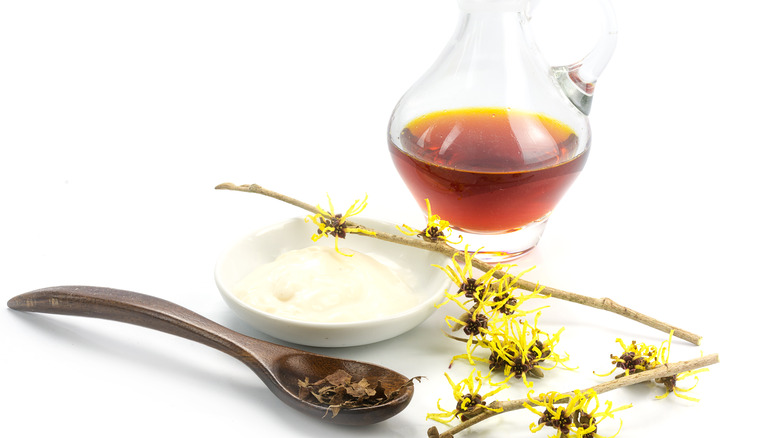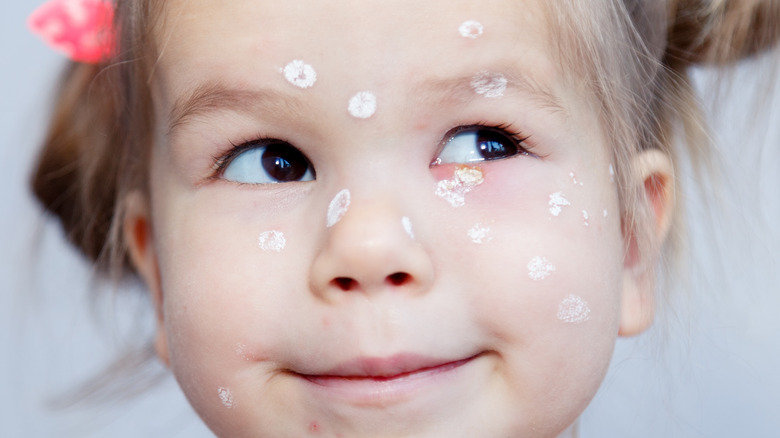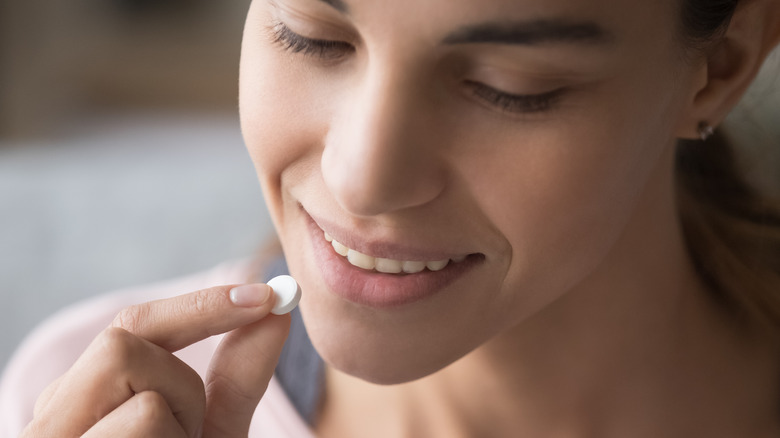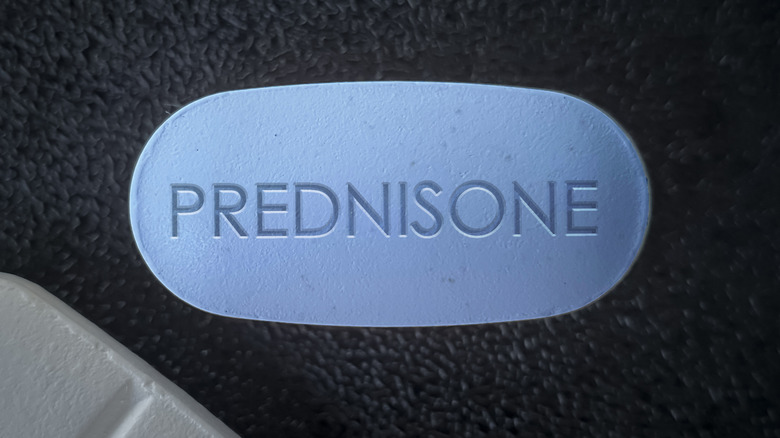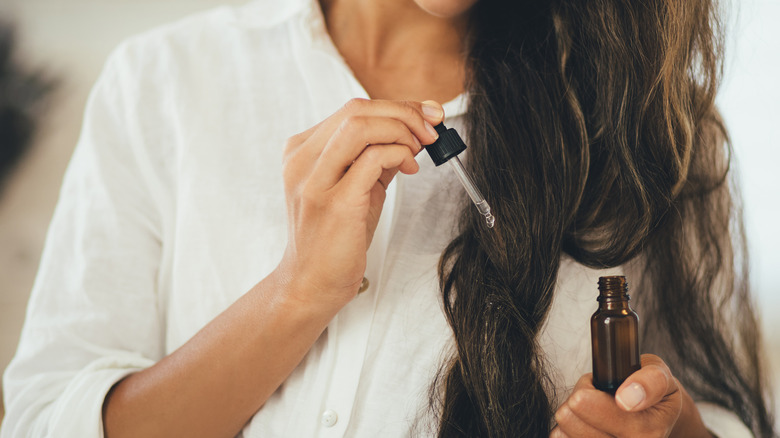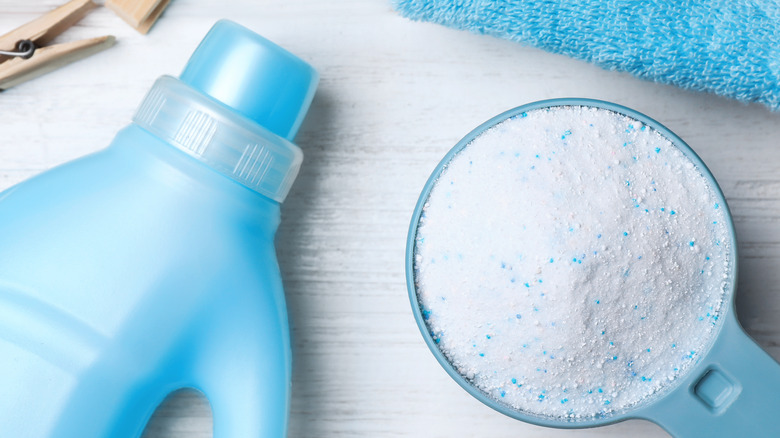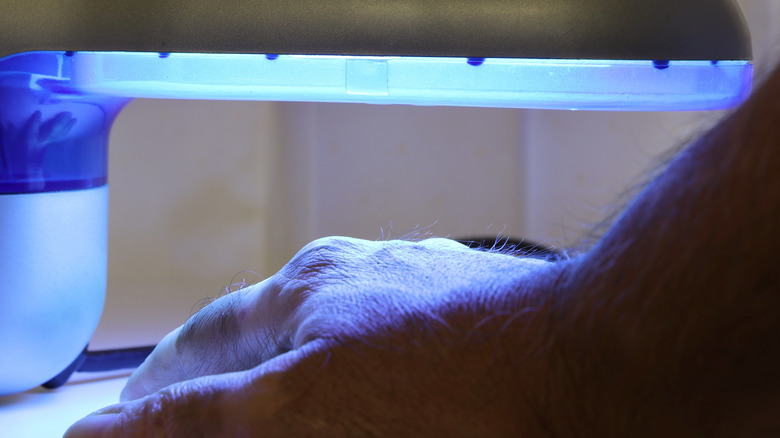14 Things You Can Do To Get Rid Of Your Rash
Rashes: uncomfortable, itchy, unsightly, annoying. Those are just a few words to describe the nasty effects of this skin anomaly that can sometimes seemingly pop out of nowhere.
While the term rash is rather general, there are actually specific types of rashes that result from various internal and external factors, all of which can appear differently on the skin (via Mayo Clinic). Atopic dermatitis, otherwise known as eczema, is among the most common skin conditions that trigger rashes. Other examples of rashes include contact dermatitis (which is caused when the skin comes in direct contact with an irritant), rosacea (which can be triggered by cosmetics and spicy food), and heat rash (which is caused by hot and humid weather). These are just a few types of rashes and their respective triggers, but the list of both rashes and triggers is much longer.
Thankfully, many of the steps to get rid of rashes are the same no matter what the type, and are mostly cost-effective. Some can even be found sitting in your kitchen cabinet. Continue reading to discover 14 ways to get rid of your lingering rash.
Use a cold compress
If you've ever felt the sweet relief of ice cold temperatures on hot, itchy, or irritated skin, you'll probably gravitate toward this solution. This technique is particularly effective for heat rash, which, according to Medical News Today, can show up as tiny red bumps that are acne-like in appearance and can provoke itching, burning, or "prickly sensations."
Heat rash occurs when sweat gets trapped in the skin and blocks the pores, creating an inflammatory response that manifests as a rash. Sweat could get trapped for a variety of reasons, including intense exercise, prolonged bed rest, tight clothing, or because of diapers (in the case of babies), according to experts.
In such situations, a cold compress can help to cool the skin's temperature, reduce inflammation, and relieve itching, burning, and irritation. You can use an ice pack or a cold cloth, but if you use an ice pack, experts recommend wrapping it up in a towel to protect the skin, and to not leave it on for longer than 10 minutes at a time. After you've applied the ice pack for 10 minutes, give it a break. Continue repeating this process until you feel significant relief.
Take an oatmeal bath
If getting in a hot bath with a rash sounds like a strange idea, just add oatmeal to it. Jokes aside, the oatmeal bath is actually a tried and true, doctor-recommended solution for a variety of skin conditions, according to Verywell Family.
Oats are a moisturizer or emollient, which can soothe irritated skin. Experts explain that oats perform this role most effectively after they've been ground into powder, so that the skin can more easily absorb its benefits. Skin conditions that benefit from an oatmeal bath include poison ivy, eczema, diaper rash, chickenpox, and many more.
While you can buy a pre-made oatmeal bath mixture at the store, it's relatively simple and cost-effective to make at home. Per Verywell Family, you'll need a way to blend the oats, warm water, and some oats to get the job done. To start, blend the oats until they are finely ground enough that they can absorb water and you get a milky-like substance. Once ground, add them to the warm, running water, breaking up any clumps. Get in the tub (or place your child in the tub), soak for 15 to 20 minutes, then dry off gently with a towel.
Apply aloe vera
Aloe vera is another classic remedy that, while simple, is extremely effective at reducing the symptoms of a rash. According to Healthline, the use of aloe vera for health concerns stretches back 6,000 years, so to say it's been vetted is an understatement.
So how does it work for irritated skin? Inside the leaves of this green plant is a clear, gel-like substance that is thick in texture and can be applied directly to the skin. The effects of this gel are soothing, hydrating, antimicrobial, and anti-inflammatory, and it also presents a cooling like sensation to the skin (per Healthline).
Experts explain that the effectiveness of aloe vera on a rash will depend on the nature of the rash, but that it is typically suitable for general irritation on the skin, heat rash, and diaper rash. It may be best used in combination with other treatments, and will work best if applied several times over the affected area. It's recommended to use 100% pure aloe vera to make sure that there are no other irritants in the product that could worsen the rash.
Use tea tree oil
You may have seen this oil while browsing the aisles of your local health food store and wondered what it's good for. According to Verywell Health, tea tree oil is an essential oil that is distilled from a tree called Melaleuca alternifolia, which is native to Australia.
The oil has been integrated into a number of cosmetic products including shampoos, facial cleansers, and soaps, and has antimicrobial and antibacterial properties, among others. When combined with other therapies, tea tree oil can be an effective treatment for rashes such as eczema (per Verywell Health). Like all other essential oils, tea tree oil is highly concentrated. Thus, before you apply it to your skin, dilute it with a carrier oil to avoid any irritation.
The site suggests looking for 100% pure tea tree essential oil, and not just products that list tea tree oil as an ingredient. It will typically come in a small brown bottle, which helps prevent it from oxidizing. Avoid applying it directly to the skin as much as possible, and do not take it internally. If you are unsure of how it will affect your skin, test it on a small patch before applying it to your rash.
Get acupuncture
This one might seem like a strange remedy to get rid of your rash, but according to science, it is actually effective.
If you are new to acupuncture, it is a treatment rooted in Traditional Chinese Medicine (TCM). A practitioner inserts thin needles into the skin along certain meridian points on the body to help improve the flow of energy (or "qi") and to stimulate the nervous system (via Medical News Today). By improving the flow of qi, the body is said to be better able to heal itself and recover from illness. Acupuncturists apply needles to acupoints on the body that are specific to eczema. These include the large intestine, liver, stomach, and spleen, all of which are associated in various ways to the appearance of eczema on the body.
Furthermore, a 2021 study published by Annals of Allergy, Asthma, and Immunology found that acupuncture reduced the itching and size of skin lesions on those affected by eczema, and declared it as a safe and effective treatment for the condition. Another study corroborates this evidence, and shows that the blood flow generated by the needles in acupuncture is also helpful to reduce irritation (per International Journal of Allergy Medications).
Try coconut oil
The benefits of coconut oil have been endlessly touted, and the miracles this oil seems to perform don't seem to be slowing down any time soon.
According to Healthline, the oil's properties may contribute to the reduction of inflammation, irritation, and itching, making it a great option for treating diaper rashes in babies and other types of rashes. Healthline also reports that coconut oil is specifically beneficial for eczema in a number of ways. First, the oil helps to rehydrate the dehydrated skin associated with eczema. Secondly, because of its antibacterial properties, it can help prevent infection that could be caused if you scratch your skin too hard.
The site suggests using organic virgin coconut oil or cold pressed coconut oil, and to avoid any products with chemicals in it that might further irritate your rash. Make sure to heat up the oil by rubbing it between your hands, so it will be more easily absorbed by the skin. Experts say that coconut oil is safe to use. However, if you have allergies to hazelnuts or walnuts, you may also be allergic to coconuts, so check first before using it.
Change your clothing
Does that sweater your grandma gave you have you breaking out in hives? Do those vintage 70's pants you bought on sale have you scratching where the sun doesn't shine? You might actually be allergic to your clothes.
According to WebMD, textile dermatitis results from your skin reacting negatively to the fabric of your clothes or other dyes or ingredients that were used to make them. While there is no specific type of clothing that is guaranteed to give you a rash, the materials that usually provoke this response in the skin are typically synthetic in nature and include polyester, rayon, rubber, and more. Experts at the site explain that these fibers don't provide as much airflow as natural textiles, leading you to sweat more.
WebMD lists formaldehyde resins in clothes to make them "wrinkle-free" as a potential concern, as well as glues and other chemicals involved in the leather tanning process. Oftentimes, buttons on pants are also made with nickel, another common allergen that is also present in jewelry, which can cause skin to turn red and itchy where contact is made. To prevent textile rashes, switch to all-natural fibers with a looser fit and less dye.
Use witch hazel
Witch hazel is another cost-effective, simple, and easily accessible remedy to treat a variety of disorders that has been used for centuries (via The Atlantic).
According to WebMD, witch hazel, also known as hamamelis, is a plant whose leaves, bark, and twigs are used both internally and externally for afflictions ranging from diarrhea and colds to skin disorders such as inflammation, insect bites, burns, and more. The most common presentation of witch hazel is hamamelis water, which has been extracted from the dried leaves, twigs, and bark of the plant. Per WebMD, witch hazel contains tannins, which are chemicals that can repair skin, reduce swelling, and act as an antibacterial agent. Furthermore, research shows that Hametum, a witch hazel-based cream, was just as effective in treating skin injury and irritation in children as another over-the-counter medication (per WebMD).
While it can be applied directly to the inflamed skin, experts at Medical News Today suggest avoiding placing it on "broken or oozing" skin. It may also be best to do a patch test on a small spot of skin before applying it liberally.
Try calamine lotion
This well-known over-the-counter remedy may have made an appearance in your childhood after you had an unfortunate brush with poison ivy.
Known for its pink tone, calamine lotion is a calming remedy that is used to treat skin conditions including shingles, chicken pox, swimmers itch, and minor burns, according to Healthline. It has been officially approved by the FDA to treat itching and irritation caused by poisonous plants, and can also prevent "weeping and oozing" caused by interactions with the plants. Per Medical News Today, calamine lotion contains zinc oxide and ferric oxide, which are what provide its healing benefits.
Before you apply calamine lotion to the affected area, experts suggest making sure the area is dry, shaking the bottle first, and gently applying it with your hands or a cotton ball to your skin (via Medical News Today). Be sure to avoid contact with sensitive areas such as the mucous membranes. Otherwise, calamine lotion is generally safe to use. Furthermore, experts caution you to be aware that calamine lotion will only relieve the symptoms of your skin irritation, but won't treat the underlying condition.
Take antihistamines
Sometimes, the best line of defense when it comes to dealing with a rash is taking oral meds. If your rash is on the more severe end of the spectrum and is causing discomfort beyond what can be healed by a liberal swipe of aloe vera, antihistamines can be an effective treatment.
According to WebMD, antihistamines block what are called histamines (hence the name), which are chemicals in the skin that can provoke allergic reactions. If you are dealing with a rash that results from hives, your doctor might recommend an over-the-counter antihistamine such as Claritin or Allegra, which come in non-drowsy forms. Benadryl is another antihistamine that can be taken at night for more severe forms of hives or allergic reactions, and can make you drowsy. Per Healthline, this type of antihistamine belongs to what's called the "first generation" of antihistamines, which in addition to drowsiness can cause a dry mouth, nose, and throat, as well as headaches.
Finally, H2 blockers are another type of antihistamine that can actually reduce stomach acid, as well as constrict blood vessels that cause inflammation from rashes (via WebMD).
Take steroids
Taking steroids may be another option for a case of an all-too-stubborn rash that won't respond to much else.
Per Mayo Clinic, a steroid such as prednisone, which is sold under names such as Deltasone and Sterapred, are designed to relieve swelling and inflammation from allergies, skin conditions, adrenal issues, and much more. The site describes it as a "cortisone-like steroid" that targets the immune system to reduce "swelling, redness, itching, and allergic reactions." According to Eczema.org, the steroids work well for eczema and can reduce the "weeping and irritation" that is caused from the skin rash. The site primarily recommends it for severe flare-ups of eczema, and says that a dose of 20-30 mg taken orally in the morning is what is most commonly taken.
Before you head to your nearest drugstore to pick up a pack, know that it is only available via prescription, so a visit to the doctor is in order first. Because steroids suppress the immune system, experts recommend that it only be used for a short period of time (per Eczema.org). Other side effects of this steroid include weight gain, osteoporosis, and mood swings.
Try lavender essential oil
If you're feeling itchy and essential oils are more your speed, feel free to add lavender to your bag of tricks. According to Healthline, lavender essential oil has antifungal properties and is an effective way to treat conditions such as ringworm, jock itch, and athlete's foot.
Like tea tree essential oil, lavender is highly concentrated and must be diluted with a carrier oil before application. A study published by The American Journal of Dentistry tested the use of lavender on animals with ulcers, and reported that the essential oil significantly reduced the size of the ulcers, lessened the inflammation, and exhibited antimicrobial effects. According to Medical News Today, these anti-inflammatory and anti-bacterial benefits make it a good option for someone managing eczema.
As with many treatments, it's best to do a patch test on your skin to make sure lavender won't irritate you. Find a high-quality oil that has either been steam-distilled or cold pressed and comes in a brown glass bottle. Make sure that you are buying pure lavender essential oils without any additives, and not just a product with lavender essential oil mixed into it.
Avoid harsh, scented products
While your nose might think of detergent as a good thing, your skin might be feeling otherwise. The chemicals in your detergent that make your clothes smell fresh and delightful are the same chemicals that can cause irritation to your skin, according to Healthline.
Contact dermatitis is the result of the skin coming into contact with these chemical irritants, and can manifest as a "red, itchy rash" that can spread widely over the skin or be localized to certain areas such as the armpits or the groin. Experts at the site explain that laundry detergents typically contain what are called surfactants, which aid in loosening dirt and oil from the fabric. If these surfactants are harsh, they can cause harm to those with sensitive skin. Artificial fragrances, colors and dyes, fabric softeners, and emulsifying agents are a few of the other synthetic ingredients in detergents that could potentially irritate your skin.
Symptoms of contact dermatitis include red bumps, oozing skin, burning skin, or dry, cracking skin. If you suspect you are dealing with contact dermatitis as a result of your detergent, you can switch to a detergent that is free of dyes and artificial fragrances. You can also rinse your load twice to get rid of any extra detergent.
Try light therapy
So you've tried everything on this list, and your rash is still persisting. Perhaps it's time to come to the light. Light therapy, that is.
While this may sound like a ... unique treatment to manage a rash, many experts can vouch for its effectiveness. Light therapy is primarily used to treat those who deal with severe cases of eczema, and employs the use of ultraviolet light to calm the skin's immune system response that causes inflammation (via Everyday Health). Experts at the site explain that it does not only help relieve the itching associated with eczema, but can also smooth the skin and decrease "skin thickening." Light therapy is a good fit for those who have already tried other options to cure their eczema, who cannot take medication, or who do not like needles.
Melissa Piliang, MD, a dermatologist at the Cleveland Clinic in Ohio, further explained: "Light therapy works well for people with targeted eczema, like on their hands or feet, because dermatologists can isolate those areas with the light" (per Everyday Health). Treatment is usually undertaken two to three times a week, sometimes even for a couple of months on end.

